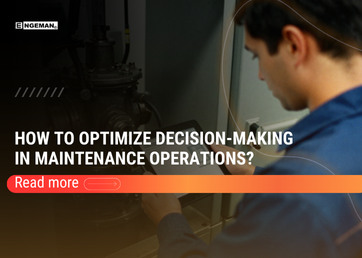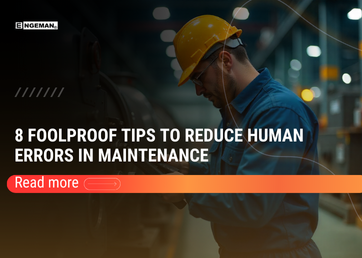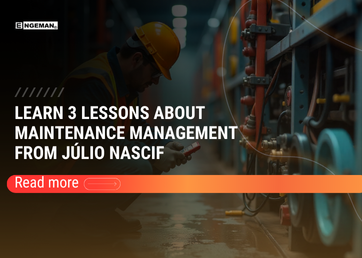Contents
- The 1st Pillar: Autonomous Maintenance
- Advantages of Autonomous Maintenance
- 1 – Initial cleaning:
- 2- Fight dirt sources and hard-to-reach places:
- 3- Develop cleaning and inspection standards:
- 4 – General Inspection:
- 5 – Autonomous Inspection:
- 6- Systemic Autonomous Maintenance:
- 7 – Autonomous Management:
- Conclusion
TPM (Total Productive Maintenance) is a management method that is commonly used in industries to optimize processes. Through TPM practices, many companies manage to improve their results and their profitability since their actions allow the prevention and correction of errors already in the production line in a planned way.
This technique was created in the 70s by the Japanese Seiichi Nakajima when Preventive Maintenance was already being widely applied. An organized work method that includes all employees of a company was then developed.
TPM is supported by 8 basic pillars. All these pillars were developed aiming to increase equipment efficiency, establishing a planned maintenance system and a team management system, among others.
Today we start a series of articles where we will talk about the TPM Pillars and the importance of applying each of them within your company. Don’t miss out!
The 1st Pillar: Autonomous Maintenance
Within the pillars of TPM, Autonomous Maintenance is one of the most used. It concerns the technical training of the professional involved in the operation. This way, operators who are in direct contact with the equipment will be prepared to use simple maintenance techniques, motivating care for the machines and thus being able to detect any eventual problem. It develops in the team the culture of “I take care of my own machine”.
Each operator is aware of his or her machine, knows its noises and is able to detect if there is any inadequate leakage. The fact that they spend many hours operating their machines gives them this skill that must be well worked on by companies that want to optimize their processes. This is not about not needing the maintenance team anymore. The idea is not to reduce the number of employees, but to contribute to greater availability of the equipment by having closer involvement with its operator.
Advantages of Autonomous Maintenance
By training and qualifying the operator to know the machine, in addition to gaining more ability to operate his or her equipment, s/he is able to help obtain a diagnosis at an earlier stage. Therefore, maintenance can avoid unexpected stops for long periods that tend to compromise production.
The involvement of operators in this stage can even be used for small repairs, through planned and guided training. When the omperator knows how the machine works, s/he tends to develop a more critical, more attentive look and this ends up generating more reliability in the result of his or her work.
Among the small repairs that can be carried out by operators, we can mention everything from cleaning and lubrication to minor adjustments to the equipment. This enhances the result as it allows an improvement in the equipment maintenance processes, and it makes it more reliable because now a series of actions are carried out that make sure that it will not break in the middle of a production process. Thus, in addition to helping with the maintenance itself, they will be trained to work with their equipment in the right way, avoiding accidents and errors.
The idea of Autonomous Maintenance is to bring employees closer to processes and equipment, in order to improve overall results. This process is carried out in 7 steps that must not be omitted to ensure the operator’s participation in increasing the availability of the equipment.
See below these steps and the importance of each one within Autonomous Maintenance.
1 – Initial cleaning:
In this first step, it is necessary to restore the basic conditions of the equipment through cleaning. It is extremely important that a proper planning is carried out, observing if there are pending preventive or corrective maintenance. It is possible to adopt the use of identification and classification labels of possible damages found and thus the responsible sector will be in charge of making the necessary repairs.
The initial cleaning aims to expose and solve any defect or malfunction found, establish the basic conditions of the machine or equipment and act in order to prevent fast deterioration.
2- Fight dirt sources and hard-to-reach places:
It is necessary to clean those equipment and places that are not visible, i. e. hard to reach. Thus, the operator will not waste time doing unnecessary cleaning.
It is also possible to make changes even to the position or location of certain equipment, all aiming to combat difficulties in accessing places that require maintenance. These practices optimize the operator’s time, as s/he has easy access and vision of all the equipment s/he is operating. Thus, the repair time will be reduced and it will generate more reliability in the maintenance of that equipment, as all areas will be visible and easily accessible, without the risk of being forgotten during maintenance.
These practices increase the preservation of equipment through cleaning, checks and lubrications.
3- Develop cleaning and inspection standards:
The objective of developing cleaning and inspection standards is to seek an alignment of processes, so that everything is clearly and in detail in easily visible places and close to the equipment. This way, the operator will know which places to keep clean at all times to make it easy to verify early problems in the equipment.
These actions contribute to greater availability of equipment based on simple inspection and cleaning practices. Here it is possible to start creating a checklist of the actions that must be carried out on the equipment.
4 – General Inspection:
The general inspection is very important because it consists of training the operator so that s/he can have a diagnosis at an early stage. To do so, s/he needs to understand the basic operation of the equipment to be able to identify possible errors.
A theoretical training is carried out, explaining the operation of the equipment and then the maintenance team will carry out practical training with the operator. Finally, an evaluation to verify if the operator really managed to learn everything and have the autonomy to carry out some inspections without the help of the maintenance team. This training is carried out by the maintenance team or supervisors who are able to transmit theoretical and practical knowledge to operators and thus qualify them for minor repairs.
The maintenance team can choose some main points so that the operator can identify these errors early, before they get worse and cause a production stoppage. If the problem is simple, the operator will already be trained for a first service.
It is at this stage that the evolution of autonomous maintenance takes a while because it is more complex and involves technical knowledge and practical training. It requires a training space so it doesn’t cause equipment unavailability. With this step completed, any operator will be able to carry out general inspections, leading to a reversal in the deterioration of some parts, thus increasing the reliability and availability of the equipment.
5 – Autonomous Inspection:
After all the preparation of the previous steps, the operator already has the autonomy to take care of inspections, cleaning and lubrication without the help of the maintenance team. The checklist that began to be developed in step 3 is complemented here after theoretical and practical training.
With continuous operator inspection, improvements can be made so that this equipment is always available. All this is possible thanks to the knowledge and skills that were acquired in the previous steps by the operator.
If it was well done, it means that the machine that is under the operator’s inspection will not break down unexpectedly as s/he is taking care of the equipment and identifying problems at an early stage so that maintenance has time to do a proper planning. Thus, the problems to be solved can be placed in the maintenance plan and planned accordingly.
6- Systemic Autonomous Maintenance:
The creation of a standard that guarantees the continuity of Autonomous Maintenance is performed in this step. The peripheral environments of the equipment are standardized. Everything around the equipment, whether tools, benches, shelves, lighting or any other item.
The points that were raised by the operator to be improved are highlighted at this stage so that the actions can be standardized.
Here it is also possible to define systematic audit activities that will be carried out by the maintenance team, the maintenance manager or another professional involved in the sector. Thus, the person responsible for TPM will establish the points to be audited, the frequency and the maintenance agent responsible for the activities. Maintenance standardization with all supporting resources is established.
7 – Autonomous Management:
This is the last phase of autonomous maintenance and is the consolidation of actions and the moment when the operator is ready to self-manage his equipment.
By knowing the equipment and now how it works, the operator is even able to point out actions for continuous improvement and thus guarantee greater availability of the equipment.
The consolidation of this step also shows the result of the effort of the entire team in each of the previous steps.
Information analysis are always performed to improve the equipment and increase its reliability. It is also possible to standardize the improvements and thus increase the useful life of the equipment.
Conclusion
All Autonomous Maintenance actions need to be carried out with proper planning and in the time necessary, so that no deficit of any stage can compromise the results.
The participation and commitment of the entire team is of fundamental importance, both operators and the maintenance and supervision team so that the long-awaited Total Productive Maintenance can generate the expected results.
Applying this methodology shows that your company is always concerned with the quality of the service provided.
Like this article? Keep following our blog, and learn all about the second pillar of TPM, which is Planned Maintenance!




